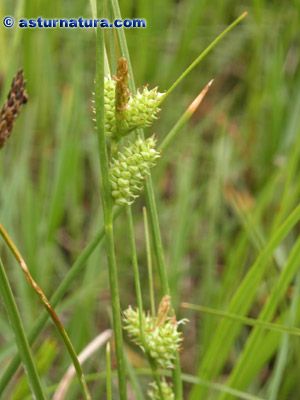Carex extensa
Beach - sedge ( Carex extensa ) in autumn
The beach - sedge ( Carex extensa ) belongs to the family of the Sedge family ( Cyperaceae ).
Distribution, location and protection
The beach sedge is common on the Atlantic coast of North and Western Europe, to the shores of the Mediterranean and the Black Sea. In North and South America, the species is naturalized.
The beach sedge inhabited wet, sometimes flooded salt meadows and pastures of the sea coasts and dune valleys of the islands. They also colonized brackish influenced sinks whose soils have a high percentage of sand and clay. The plant prefers base -rich soils. It comes in Germany exclusively in the North and Baltic Sea coast. Close to nature, the beach sedge on the Baltic Sea also occurs in the area of sandy beach. Your main deposits it has in halophytes hallways. Phytosociological it is the Kennart the plant community ( association ) of the Junco Caricetum extensae and that of the Association Armerion maritimae.
The beach sedge stands in Germany on the red list of endangered vascular plants and is classified as endangered there. Your portfolio development is currently regarded as constant. The plant is threatened mainly by coastal protection measures and the lack of flooding of salt meadows and marshes.
Description
The sour grass is a perennial, overwintering green Hemikryptophyt. It reaches heights of growth 10 to 30, sometimes even 50 centimeters high. It grows in small, relatively permanent nests, which in turn can form dense lawn. The truncated triangular, smooth stems grow upright and are leafy only at the base. The lower leaf sheaths are brown to rust-colored and not fray. The stiff and thick leaf blades are gray-green, rinnig and often at margins rolled. They are 2-3 mm wide. The short, triangular ligule are indistinct. The bracts are up to 10 centimeters long. They are deciduous leaf-like and often longer than the inflorescence.
The different eared inflorescence is between 2 to 5 inches long with three to five seated, usually approximated each other ears. At the top is a terminal, cylindrical spike with male florets. Below usually are 2 to 4, oblong- ovate spikes of dense female flowers. The bracts are formed foliage leaf-like. The yellow to red-brown glumes are keeled and mucronate green. The male blossoms have three stamens. The significant two - to three -edged utricle (fruit tube) is about 3.5 millimeters long and wrapped three scars. He wears a short bidentate beak at the top. He is initially colored gray-green. When mature, it changes to brown color.










